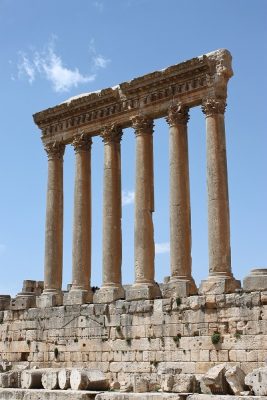The Temple of Jupiter is located at the Baalbek ruins in Syriaca, modern-day Lebanon. It is the most massive temple built by the ancient Romans, designed as a place of worship for a god that went by different names in different eras: Hadad, Ba’al, Zeus, Helios, or Jupiter. The colossal temple is located at the western edge of Heliopolis, an ancient complex of temples in ancient Lebanon. Religious worship had occurred in this complex for many centuries.
It is not known who ordered the temple’s construction nor who designed it. The Syrian historian John Malalas estimates that the temple was built during the rule of Antoninus Pius (AD 138-161). On the other hand, it is widely believed that the temple’s construction began in AD 16 after a Roman colony named Colonia Augusta Felix Heliopolitana was established in Baalbek. The temple was completed in AD 60, as engraved on one of the column drums.
Structure
The Temple of Jupiter stands on an elevated podium. Of all the Roman temples, it is the largest dedicated to Jupiter. The sheer size of the stones used in this temple is staggering. Historians have been awed by the size of the three stones at the west end, measuring about 19 x 4 x 3.6 meters. These stones, collectively known as the trilithon, each weigh more than 800 tons. In front of the temple’s elevated podium are stairs that measure 47.7 meters wide and 87.75 meters high. The temple itself was surrounded by 54 Corinthian columns, with four columns on the corners, eight columns each at the front and back, and 17 on both sides. The columns stood 19.9 meters high, and each had a diameter of 2.25 meters. However, only nine of the 54 columns were left standing, and in the early part of the twentieth century, an earthquake reduced them further to six. At the top of these columns rested a pediment, whose apex is estimated to have reached 44 meters above the temple’s floor. The rectangular base of the temple is 88 meters long and 44 meters wide.
Function
The Temple of Jupiter, the largest temple in the ruins of Baalbek, was built in honor of Jupiter Heliopolitanus. According to the Latin grammarian and philosopher Macrobius Theodosius, there was once inside the temple a statue of Apollo, or Zeus, made of gold, depicting a beardless young man.
He states that the statue was shipped from Egypt, and its right hand was raised, clutching a whip, while the left hand clasped a bolt of lightning and some ears of grain. The statue was believed to have worn symbols of the sun and moon on its chest, with two bulls guarding it on either side. It had on its head a kalathos, or a fruit basket shaped like a hat, symbolizing fruitfulness and fertility, which have always been associated with the sun. Not surprisingly, the temple faces east.
The temple was also used for oracular activities. Macrobius tells us that during an oracular ritual, a statue of Jupiter, possibly a smaller version, was placed in a litter, or ferculum. This ferculum was then carried by priests to different corners of the temple. In this way, the priests interpreted the will of the god. Emperor Trajan is believed to have received a prophecy from the Temple of Jupiter in AD 114. The prophecy stated that he would not be able to come back alive from his wars against the Parthians. Indeed, in AD 117, while sailing back to Rome after destroying the Parthian capital of Ctesiphon, he died of a stroke.
Construction
How the builders moved the massive stones from the quarry to the construction area has been a great mystery to historians. However, the mystery is lessened by the fact that there are two quarries near Baalbek. One is to the south, while the other is about a kilometer away to the west of the ruins. This is where the stones were most likely cut and prepared for the structure. Still, the question stands as to how the builders moved the huge stones without modern technology. Some sources say that cranes were specially built by the Romans, although the weight of the stones would have required several specially-built cranes. The height of the quarry, in comparison with the temple ruins, may offer an insight. The quarry is somewhat at a higher elevation, and it is possible that after cutting the rock, the builders may have placed hard logs under them to serve as rollers. An informational signboard placed at the ruins by the local tourism office states that after the stones were cut, 512 slave workers manned 16 separate pulleys to draw the stone towards the construction site. Afterward, slave workers filled the site with sand, then positioned the huge stones on the sand. The workers then had to dig out the sand to lower the stones.
In Later Centuries
The Temple of Jupiter enjoyed adornments by later Roman emperors. The emperor Septimius Severus and his son, Caracalla, installed a propylaea, or monumental gateway. This was improved upon by Philip the Arab, who added a hexagonal court to the temple. The coming of Christianity, though, signaled the deterioration of the temple and the fading of the oracle. Between the year AD 378 and 395, Emperor Theodosius ordered the closure of the temple in his efforts to weaken paganism.
The ecclesiastical historian, Zacharias Rhetor, records that in AD 524, lightning destroyed the temple. Following this, Justinian, who ruled from AD 527 to 565, ordered the surviving columns of the temple to be salvaged and shipped to Constantinople to be reused in the Hagia Sophia. The most drastic change came over the temple during the Crusades when the remaining stones were restructured to build a fortress.
